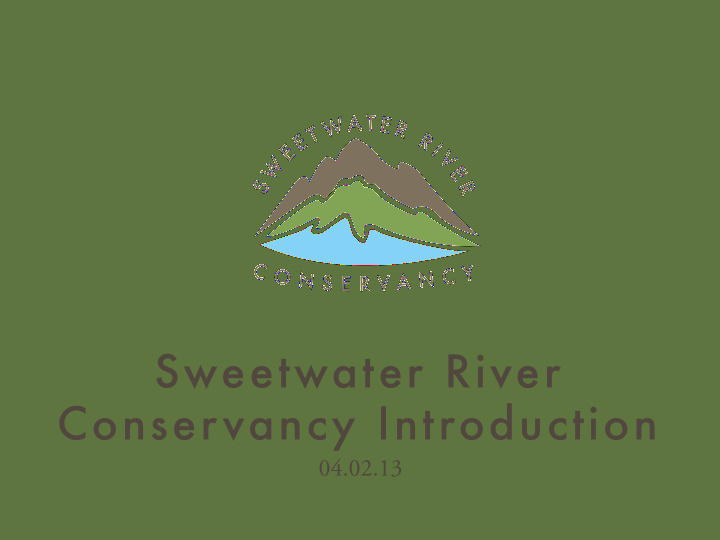



Sweetwater River Conservancy Introduction 04.02.13
Mitigation and Conser Mitigation and Conservation Banking an Intr ation Banking an Introduction oduction • The concept of mitigation and conservation banking have been around since the 1970’s and became regulated in the 1990’s. • Mitigation and Conservation banking create an economic incentive for restoring, creating, enhancing and preserving wildlife and habitat while facilitating development. • Mitigation and Conservation Banks result in the consolidation of small mitigation and conservation projects into a larger, potentially more ecologically valuable site providing greater diversity of habitats and function. ¡ ¡ ¡ ¡
Mitigation and Conser Mitigation and Conservation Banking an Intr ation Banking an Introduction oduction • Mitigation and Conservation Banks provide a greater likelihood of improving ecological values, since the banks are approved and operating prior to the impact occurring. • Mitigation and Conservation Banks are required to provide financial securities to guarantee the viability of the banks for perpetuity.
Mitigation and Conser Mitigation and Conservation Banking an Intr ation Banking an Introduction oduction All mitigation and conservation banks are • governed by a banking instrument which describes in detail the physical and legal characteristics of the bank, including how the bank will be established and operated. • The instrument is approved by an Interagency Review Team comprised of State and Federal agencies. • The approved instrument serves as documentation of agency concurrence. • Each instrument includes a development plan, management plan, conservation easement language, financial assurances, credit & debit methodology and a description of the geographic service area.
Mitigation and Conser Mitigation and Conservation Banking an Intr ation Banking an Introduction oduction • There are three main types of third party offsets. • In Lieu Fee (Payment Only) • Conservation (Preservation) • Mitigation (Active Restoration, Enhancement and Preservation) • None of these actions replace the sound practice of avoidance and minimization.
Mitigation and Conser Mitigation and Conservation Banking an Intr ation Banking an Introduction oduction • The Geographic Service Area or GSA is defined under the banking instrument and is physiographic area within which the mitigation bank is authorized to provide compensatory mitigation to third parties. • A GSA is defined by a watershed, ecoregion, species range, genetic populations, or other scientifically justifiable rationale • All sale of credits with in the GSA represent a Like Kind exchange. – Example 1 for 1 • Out of Kind transactions are approved by the governing agency at there discretion and require more credits to offset the impact than if it were located in the Primary Service Area. – Example 2.1 for 1
Mitigation and Conser Mitigation and Conservation Banking an Intr ation Banking an Introduction oduction
In Lieu F In Lieu Fee ee • The practice of the payment of a fee as an offset to an impact to a regulated species or habitat. • There is still a loss of in species or habitat. • The dollars are invested in research or conservation projects.
Conser Conservation Banking ation Banking • Conservation banks permanently protect lands that contain natural resource values. • These lands are conserved and permanently managed for species that are endangered, threatened, candidates for listing, or are species-at-risk. • Conservation banks function to provide offsite compensation for adverse impacts to species of interest. • In most cases the lands conserved are a multiple of the lands impacted (Example 4x)
Mitigation Banking Mitigation Banking • Mitigation banking is the practice of restoring, creating, enhancing, and preserving off-site wetland, stream bank and upland habitat areas to provide compensatory mitigation for authorized impacts to these resources. • Mitigation banks facilitate development in a responsible manner. • The compensatory offset is provided by a third party mitigation bank. • This is in contrast to permittee-responsible mitigation, where the permittee compensates for its own impacts either on or off-site.
Why Buy Cr y Buy Credits edits ¡ • Mitigation and conservation bankers assume total responsibility for the mitigation and or conservation and guarantee perpetual maintenance of the bank’s environmental assets. Mitigation or conservation is typically performed prior to the impact, therefore reducing or eliminating temporal loss of functions. • Save time and money: The developer does not have to go through the time-consuming permit approval process to create, restore or preserve a wetland, riparian buffer or stream reach or upland habitat. One of the benefits described in the Federal Guidance for the Establishment, Use and Operation of Mitigation and Conservation Banks is that “Use of banks may reduce permit processing times and provide more cost-effective compensatory mitigation opportunities for projects that qualify.”
Sw Swee eetw twat ater Riv er River Conser er Conservancy ancy • Sweetwater River Conservancy is a privately held and funded Mitigation and Conservation Project. • The Sweetwater River Conservancy is sited on nearly 100,000 acres of deeded lands located in central Wyoming. • The Sweetwater River Conservancy lands are rich with history, cultural resources, wildlife and diverse habitats.
Recommend
More recommend